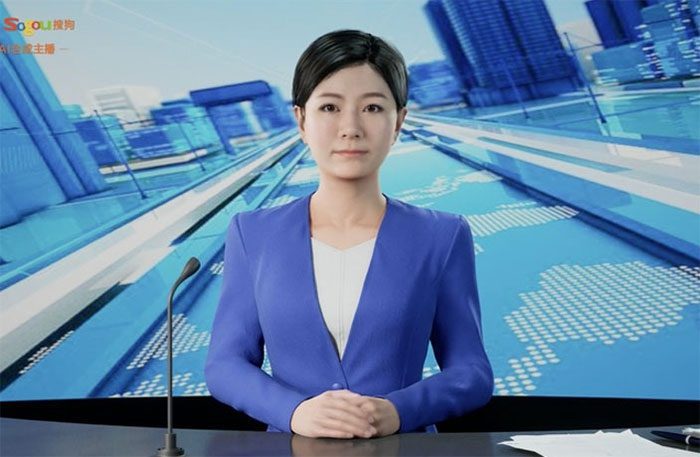With a real appearance, voice, and behavior, these female broadcasters are actually AI-generated images.
Nadira – one of the newest presenters at tvOne – recently reported live in English about the election campaign in Thailand on television. Just two days earlier, she had fluently presented news about the 32nd SEA Games in Indonesian. Notably, this broadcaster always maintains a professional expression and impeccable attire.
In reality, Nadira is one of three virtual television presenters introduced by tvOne in April. This is the most-watched television network in Indonesia. Nadira is designed based on the veteran broadcaster Fahada Indi from the channel. Her voice and movements are also modeled after Indi. According to Rest of World, both share significant similarities in appearance and behavior, especially in the characteristic hijab.

Three virtual presenters appear on Indonesian television. (Photo: tvOne).
Inspired by Real Celebrities
In a world where the use of robots and AI to replace human labor is increasingly criticized, the editors at tvOne believe that leveraging the latest technological advancements is a “privilege” that brings substantial practical value. “It helps me a lot because I don’t always need to be in the office to work,” broadcaster Fahada Indi shared.
Indi and her “clone” Nadira work alongside each other. While Indi delivers breaking news live from the field, Nadira presents from the studio.
tvOne’s translation system uses artificial intelligence to convert Nadira’s voice into various languages, including English, Chinese, and local Sundanese and Javanese. This enables the television station to reach a diverse audience in a country with over 300 ethnic groups like Indonesia.

Nadira is a virtual presenter on Indonesia’s tvOne. (Photo: tvOne).
According to Rest of World, digital avatars have recently become popular in Indonesia and are referred to as “metahumans.” Not only broadcasters, many virtual avatars are also beloved celebrities or even spokespersons for the Immigration Bureau at Soekarno-Hatta International Airport in Indonesia.
“AI will become the most influential technological revolution for humanity,” asserted CEO Sam Altman at a recent event in Jakarta.
Specifically, the Immigration Bureau at Soekarno-Hatta International Airport has become the first government office to use metahumans in its operations. The agency has introduced four virtual staff teams specializing in assisting with immigration processes.
Some avatars are modeled after famous Indonesian figures like Ahmad Al Ghazali, Anjasmara, and Ario Bayu. These virtual avatars will serve as communication specialists for the public service department, always maintaining a friendly demeanor, continuously updating knowledge, and representing the government.
At tvOne, each virtual avatar represents a demographic group in Indonesia. However, they still lack real interaction capabilities despite being built on AI software.
In promotional videos, the avatars’ audio is completely out of sync with their visuals, and their appearance does not match the plain backgrounds behind them. As a result, Indonesians are not particularly impressed with these “metahumans.”
Difficulties in Utilizing AI Due to Lack of Understanding
Justito Adiprasetio, a lecturer in communication studies at Padjadjaran University, stated that although many media organizations in Indonesia have begun using AI, they still do not fully understand this technology.
“Many media companies use AI to enhance their brand, but they lack the ability to utilize it effectively because they cannot optimize all the capabilities of AI without understanding its benefits and consequences,” Adiprasetio noted.

China is home to the world’s first AI television presenter named Xinhua. (Photo: That’s Mag).
According to Rest of World, AI-supported digital products still exhibit distinct differences compared to those entirely created by AI. Most “metahumans” at present remain digital products with AI intervention. For instance, Vira, a “metahuman” appearing as an AI chatbot for BCA Bank.
tvOne’s CEO Taufan Eko Nugroho believes that these “metahumans” still need real human interaction to gain the trust of the audience. Therefore, the station’s team has experimented with broadcasting news led by AI.
However, they realized that real human presenters were still more effective in terms of phonetics and intonation. According to him, when news broadcasts are still controlled by humans, the station can avoid the risks associated with AI products such as misinformation and bias.
These virtual presenters are designed and operated by an internal team at tvOne. They plan to develop more new avatars in the future. Vice President Norma Dani Risdiandita and Widya Wicara of this team affirm that humans cannot be entirely replaced.
“Human creativity is still essential to supplement the deficiencies of virtual presenters. AI still has a long way to go to match our creative minds,” Risdiandita stated.





















































